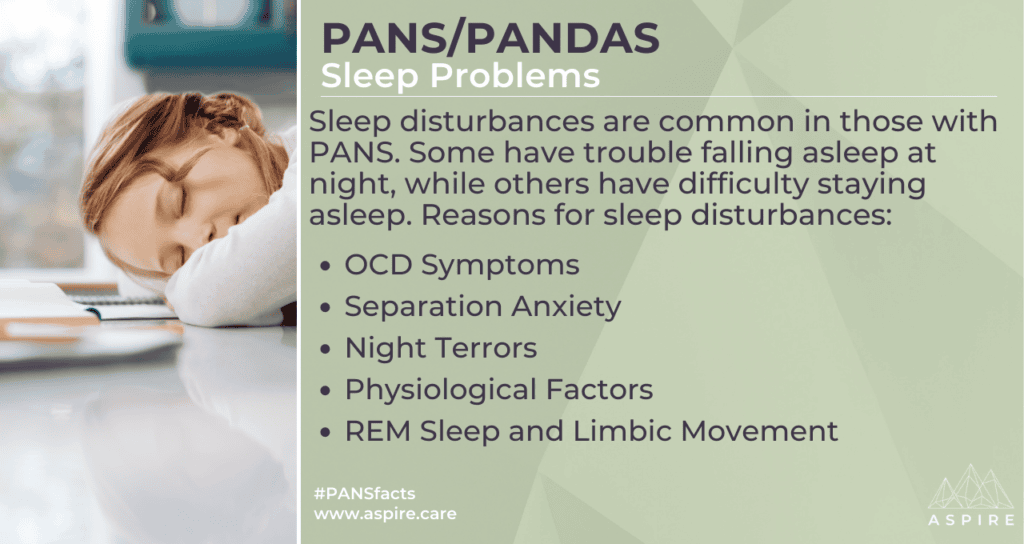Sleep disturbances are common in children with PANS and are part of the diagnostic criteria.
See more about the PANS PANDAS Diagnostic Criteria and Symptoms
Some have trouble falling asleep at night, while others have difficulty staying asleep. One cohort from a study from the Stamford PANS Clinic “demonstrated increased onset of REM sleep (median 134 minutes), insomnia (median total sleep time of 389 minutes), and decreased sleep efficiency (77%).”

OCD and Sleep Disturbances
Fears or intrusive thoughts may keep their minds too busy or too anxious to fall asleep.
They may worry that something bad will happen to them or their family while they are asleep. OCD fears and rituals can create hundreds of obstacles to falling or staying asleep. Some children have hour-long bedtime rituals that must be completed before they can go to bed. The need to do compulsions can be so constant that children can’t fall asleep. A child may feel she or he has to stay in a certain position all night or count the number of teeth in their mouth a hundred times. Cognitive Behavioral Therapy and Parent Management Techniques may help curb these prolonged behaviors.
Separation Anxiety & Night Terrors
Separation anxiety may also play a role in causing sleep disturbances. PANS children often need someone in the room with them to go to sleep. They may need help calming down or reassurance as they fall asleep. It is not uncommon for parents to stay in the room until their child is sleeping or allow them to sleep in the parent’s room or bed. Nightmares and night terrors are also common and can contribute to difficulty sleeping.
Physiological Factors
In addition to fear and anxiety, there may be physiological reasons that children struggle to sleep. Infections and immune activation can adversely impact sleep. Inflammation can decrease serotonin, increase dopamine, and prevent melatonin from being produced.
These neurotransmitter changes can all cause insomnia. Also, many children are in a constant state of fight or flight. They may feel that there is a constant danger, which keeps their system active and alert. There may also be other comorbid medical issues such as reflux or POTS, which can impact sleep for children with PANS.
REM Sleep and Limbic Movement
Many PANS children are unable to suppress movement during sleep which can disrupt REM sleep. Disinhibited movements during sleep include excessive movement, hand stereotypies, laughing, moaning, or periodic limb movements during sleep (PLMS) into REM sleep.
Sleep disturbances in PANS patients happen during the acute phase of the illness but may continue several years after treatment, especially in those in a chronic static state of the disease. These continue sleep disturbances may be a factor in why some patients have prolonged symptomatology.
Sources:
- Rapid Eye Movement Sleep Abnormalities in Children with Pediatric Acute-Onset Neuropsychiatric Syndrome (PANS)
- Continued Presence of Period Limb Movements During REM Sleep in Patients With Chronic Static PANS